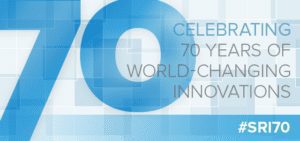It is gratifying to look back on 70 years of innovation at SRI and to reflect on the high-impact solutions that our independent, nonprofit research institute has brought to the world. Although the world has changed dramatically since our founding in 1946, there is a thread that weaves through SRI’s history that connects the SRI mission of today with its founding charter.

Now, as in our early years, the challenges faced by our government and commercial clients require new ideas and approaches. Today, researchers across SRI are applying their expertise to critical areas ranging from cybersecurity, to the transformation arising from the “Internet of Things” (IoT), to the societal implications resulting from an aging population. Indeed, it’s precisely in these and other complex challenges that SRI sees the greatest opportunity to help make the world safer, healthier and more productive.
And just as in our founding days, SRI’s approach starts with establishing a deep understanding of the current and future needs of our partners and customers – first to pinpoint the critical problems and opportunities and then to assemble an optimal team to develop solutions that benefit from the breadth of technical expertise across SRI.
SRI was created in 1946 in the aftermath of World War II—a time of hard-won optimism in the country. There was a deep recognition by the American public that it owed its scientific and technical community a tremendous debt for the impact scientists and engineers had made in preserving national security.
During this period, the scientist Vannevar Bush, in a paper written for President Truman entitled “ Science, The Endless Frontier,” outlined a national policy on science and technology that argued for the primacy of scientific research as the backbone of a strong and secure nation.
It was in this positive climate for the sciences that Stanford University created SRI as a non-profit research institute that would, in the words of its founding charter, “ promote and foster the application of science in the development of commerce, trade and industry… and the improvement of the general standard of living and the peace and prosperity of mankind.”
Initially, SRI restricted its focus to the western United States, and partnered with regional industries to support their needs for basic and applied research. But the focus of those years rapidly broadened as SRI began to serve national, and eventually, international clients, in both government and commercial sectors. In its first half dozen years SRI conducted ground-breaking work by developing the first computer banking system (ERMA); produced one of the earliest studies of air pollution and its effects on the ozone layer; and created an economic and environmental feasibility study that led to the creation of a true icon of American life—Disneyland.
As SRI became one of the most trusted independent research partners of key federal agencies, it produced thousands of solutions for clients, including the Defense Advanced Research Projects Agency (DARPA) and other national and homeland security agencies, the National Institutes of Health, Department of Energy, National Science Foundation, and the Department of Education.
These research engagements generated important solutions in the fields of computing science, engineering, materials science, robotics, artificial intelligence, atmospheric science, health sciences, education policy and many more. What’s equally impressive is that SRI has successfully transitioned many of these inventions into consumer as well as government applications. One signature example is SRI’s foundational work developing the first three-way internetworked communication. This novel networking project became the Internet.
In the 1960’s, Doug Engelbart, the director of SRI’s computing team, had a vision for “augmenting the human intellect,” a vision that guided his team to develop breakthrough models for human-computer interaction. In 1968, in what has now been dubbed “The Mother of All Demos,” Engelbart introduced the first computer mouse, video conferencing, teleconferencing, hypertext, word processing, hypermedia, object addressing, dynamic file linking, and a collaborative real-time editor—all technologies that are now so firmly ingrained in our everyday digital experience that we take them for granted.
We’re very proud of our track record of moving innovations from lab-to-marketplace—creating over 60 new ventures based on our discoveries, which places SRI at the top of all research organizations in converting its R&D into high-impact, real-world solutions.
Today, SRI remains a remarkable place for scientists and engineers to come to create the future, work across boundaries with like-minded people, and develop cutting-edge technologies in a spirit of entrepreneurship, and for the common cause expressed by our mission—to change the world, making people safer, healthier, and more productive!
I can only imagine, with wonder, what SRI will be able to accomplish in the years ahead. The problems we work on are certainly different from the ones SRI researchers tackled in 1946, but they are equally complex, and require the same concerted effort, curiosity and collaborative spirit that have characterized SRI from its very first days.


